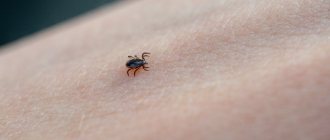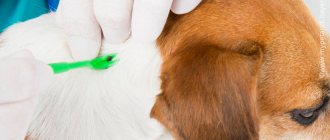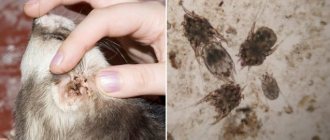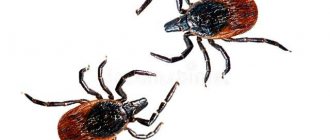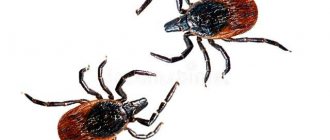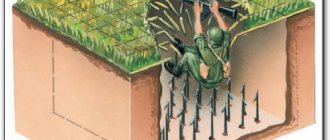Ixodid ticks inhabit places with dense vegetation - parks, forests and alleys, where there are a lot of bushes, trees and grass.
If a blood-sucking parasite gets on the dog’s body, the owner of the animal must react as quickly as possible and remove the parasite.
If this is not done, along with the specific secretion that the tick injects during suction, various blood-parasitic infections penetrate into the blood, threatening not only the health of the pet, but can also cause death.
Rules for removing a tick
If you find a tick embedded in your body, you must immediately contact a medical facility . If this is not possible, you need to try to remove the tick yourself, following a number of rules:
- do not pick up insects with bare hands;
- do not pull him out by the belly;
- do not pick with a sharp object;
- do not jerk sharply;
- do not burn with fire or cigarette;
- Do not lubricate the wound with gasoline or other similar liquids, which is often done by people.
You cannot pull out a tick with your fingers, as there is a risk of crushing the insect and becoming infected. Lubricating the bite site with some liquid will make the tick fear for itself, which will result in the injection of toxins into the human body.
how to remove a tick yourself
Actions of the owner if part of the insect remains under the skin
If mistakes were made when removing the pest, part of it (head, legs) may remain inside.
To remove them, you need to find the remains under a magnifying glass (they look like black dots), pick them up with a needle and pull them out, similar to a splinter. The needle must be pre-heated and treated with alcohol.
If the remaining part is deep or not visible, you should contact your veterinarian, he will remove them by making a surgical incision.
Removing a tick using tweezers or thread
It is important to take the procedure as carefully as possible. To pull out the bloodsucker, you can use ordinary threads. A loop is made from such a thread, which is carefully draped over the tick. When the loop is located close to the insect's proboscis, you need to tighten the knot and, without much effort, gradually pull the thread perpendicular to the skin. If you gently and gradually pull without jerking, the tick may come off.
You can also use tweezers to pull out the tick, with the help of which the insect is captured between the head and the human body. It is important to control not to grab the insect by the abdomen, as this increases the risk of crushing it.
The tick is pulled out gradually, by slowly pulling around the axis (you can twist it either clockwise or counterclockwise). If successful, the tick will be completely pulled out after 1 – 3 turns.
how to remove a tick correctly
Diseases and symptoms
As already noted, a tick bite can cause serious diseases, the most dangerous of which are:
Piroplasmosis or babesiosis
The most common disease, dangerous for dogs of all breeds and ages. The incubation period is up to two weeks. Symptoms:
- lethargy;
- temperature increase;
- refusal to eat;
- thirst;
- mild jaundice - the mucous membranes become pale, with a yellowish tint;
- at the peak of the disease, the urine becomes dark, sometimes with a red tint;
- diarrhea, yellowish or greenish stool color;
- vomit.
Borreliosis or Lyme Disease
An infectious disease that can affect all systems of the body, because of this, the symptoms in each individual case are very different. The appearance of any symptoms may begin several months after infection!
Ehrlichiosis
An infection that affects several body systems at the same time. The incubation period ranges from several weeks to several years. This disease knows how to wait. First warning signs:
- poor appetite;
- elevated temperature;
- depressed state;
- reluctance to play;
- sudden weight loss;
- vomit;
- diarrhea;
- bruising on the mucous membranes and skin.
None of these diseases can be waited out or cured at home; at the first suspicion, immediately contact a veterinarian!
A special device - “twister”
Today it is possible to purchase a special device - a twister. The device does not allow squeezing the tick, which distinguishes it from tweezers and minimizes the risk of infection. Externally, the twister is similar to a small nail puller, but its dimensions can be different, taking into account the size of the plier. Using a twister, the tick is grabbed from the side and pulled up with a little effort.
pliers twister
Prevention
The basis of prevention is timely treatment and examination of the dog after each walk. For treatment against external parasites, the most effective modern means are tablets:
Nexgard
Bravecto
Simparica
Drops on the withers are also effective:
Advantix
Frontline
Collars are not very effective and can only be used in combination with other drugs.
Pulling out a tick with a syringe
There is another household method for removing a tick. It involves using a knife and a regular medical syringe, preferably an insulin one, but a 2 cm3 capacity is also suitable. The procedure is quite simple to implement and anyone can perform it. Using a knife, cut off the end of the syringe along with the needle. It is important to make the cut as smooth as possible. The finished product is tightly applied to the site of tick suction and the air is pumped out of the syringe. The vacuum formed in the resulting capsule should push the bloodsucker out of the wound it created. This method allows for the formation of a small bruise, but these consequences are disproportionate to the risk of contracting a disease dangerous to health.
how to remove a tick with a syringe
What happens when a tick gets on an animal?
After the parasite gets onto the dog’s fur, it spends 3-4 hours looking for the most suitable place for suction, since it needs tissue areas with a developed capillary system. The tick carries out its “bite” with a special organ, the hypostome, which does not have grasping devices and operates on the principle of a vacuum suction cup. The bite does not cause pain to the animal and goes unnoticed in most cases. But as a result of microtrauma, inflammation forms in the affected area, which the dog begins to immediately scratch.
When a tick is detected, the first step is to pull it out, since the initial bite does not guarantee infection, but this probability increases with the time the parasite remains on the skin. It should be remembered that when removing a tick at home, you must submit the remains of the removed insect to a laboratory for analysis. It is also possible to take your own steps against ticks.
Do I need to use oil?
There is a fairly widespread opinion in society that when the bite area is lubricated with oil, the tick falls off on its own. This opinion is not only wrong, but can also be harmful. Oil cannot be used for these purposes for the following reasons:
- Tick breathing occurs through the back, the oil on which will help the tick to suffocate. The dead insect will remain in the body and will be difficult to remove.
- The oil will frighten the tick and it will splash its dangerous substances into the body. In this case, infection can hardly be avoided.
When and where to look for ticks in a dog's fur?
It takes a tick from 3 to 24 hours to infect an animal. Therefore, after being in the fresh air, no matter if the pet is walking in a forest area or in an urban environment, it is necessary to check the dog’s body for the presence of attached parasites. Ticks like to hide most of all in these places:
- around the muzzle;
- around the neck;
- in the ears;
- in the groin area;
- between fingers and pads.
The most dangerous period when ticks are in the active stage of development is the period from March to October, depending on the weather conditions of the region.
Typically, a dog that has become a victim of a tick attack shows external signs, upon noticing which it is necessary to immediately carry out an examination:
- lethargy;
- drowsiness;
- depression;
- little mobility.
Where to put the tick after removing it?
The extracted insect must be preserved for research to determine if it is infected with infections. Analyzes are done in laboratory conditions, including in our EL Clinic.
The methods of removing a tick from the body described above, if the rules for their implementation are followed, allow the insect to remain alive. This is important for the laboratory to accept the bloodsucker for analysis for borelliosis, a tick-borne disease. To deliver the tick to the laboratory, you need to place a piece of fabric or moistened cotton wool on the bottom of the jar, on which the bloodsucker is placed.
Danger of ticks in dogs
The peak activity of ixodid ticks is recorded from mid-May to mid-October. The most dangerous months are July and August. Ticks are able to sense their potential victim while being 10 meters away from it. Choosing the right moment, the parasite jumps onto the animal’s body.
It is important to note that the tick does not immediately attach itself to the dog’s skin, but looks for the most delicate areas with a good blood supply. From the moment the tick hits the dog’s body until it attaches itself, it takes from 60 minutes to 3 hours.
After choosing a place to bite (as a rule, this is the muzzle area, ears, elbows and groin area), the parasite pierces the skin with its piercing-sucking mouthparts. Having found a suitable place, the tick can remain on it for a long time.
The head of the tick penetrates deeper under the skin every hour, and it is much more difficult to get it out after a long period of time.
In addition to the fact that an ixodid tick bite can cause a local inflammatory reaction, there is a high risk of infection by helminths, viruses and bacteria. Ixodid ticks carry piroplasmosis, also called canine encephalitis and ehrlichiosis.
The insidiousness of ixodid ticks is that their bite is absolutely painless for the animal, so it is much more difficult to detect the parasite.
What to do with the dog?
Regardless of the results of actions aimed at removing the tick, an examination of the bitten animal by a veterinarian is required. If necessary, the doctor will prescribe a course of medications that will help prevent complications.
It is important to monitor your dog for several weeks after a tick attack. If you notice a deterioration in your health (decreased activity, problems with appetite, increased temperature, difficulty urinating, painful appearance), you need to consult your doctor again.
Consequences of delayed assistance
If appropriate measures are not taken, the tick will become saturated with blood in a few days and, most likely, will fall off the dog.
A wait-and-see attitude is dangerous because during the specified period many toxic (poisonous) substances, allergens, and pathogens of infectious processes will enter the animal’s blood. The result is a significant deterioration in the dog’s health (even death).
Dangerous ways
To prevent complications, it is recommended to refrain from risky methods of tick removal that involve treating the parasite and the bite site with wax, oil, gasoline, alcohol and other aggressive substances.
It is also extremely unsafe to use open fire, which not only will not solve the problem, but will also aggravate it, causing skin burns in the animal.
Using unsafe methods can harm your pet and cause burns. Use these methods only as a last resort!
The parasite, sensing a dangerous impact and experiencing a lack of oxygen, secretes saliva and regurgitates the contents of the stomach into the wound. As a result, preconditions are created for the development of infectious diseases.
What to do if you couldn’t remove the tick’s head?
If the head of the arthropod remains under the skin, you need to arm yourself with a sterile needle and remove it (like removing a splinter). In some cases, you will need to make small incisions.
If the parasite is not completely removed, the remains of its body will continue to poison the dog’s body and cause fester!
Leaving the head in the wound and expecting the problem to resolve itself is a risky decision. There remains a considerable probability of inflammation, suppuration and spread of infection throughout the body.
How to care for the suture after surgery?
Once the edges of the incision tighten, there will be no need for additional support. Removal of sutures in the head, face and neck area occurs already on the 5th day after the operation. If they were applied in the area of the torso or limbs, then it will take at least 10 days for the wound to heal. Daily dressings are necessary for the first few days. The patient usually spends this time in the hospital. After discharge, tight bandages are usually no longer needed. But if necessary, you can always change the dressing at the nearest hospital or medical center.
Caring for the suture after surgery consists of daily treating the incision area with an antiseptic and taking medications that accelerate tissue regeneration. All medications for home therapy are used strictly according to the doctor’s recommendation!
Treatment of sutures is usually carried out with ready-made pharmaceutical preparations or homemade antiseptics, such as solutions of iodine, potassium permanganate, brilliant green or hydrogen peroxide. To avoid getting a chemical burn when performing such procedures, the liquid for disinfection should be prepared only according to a prescription issued by a doctor.
To speed up regeneration processes, external agents with wound healing and antibacterial effects are used. These include balsamic liniment (better known as Vishnevsky ointment), levomekol, ichthyol ointment and many others.
Pain of varying intensity after surgery is absolutely normal. If discomfort is severe, analgesics approved by your physician may be used.
The tick has been eliminated. What's next?
If your dog is treated for ticks (for example, with a Simparika tablet) on time and in accordance with its weight, then simply monitor the animal for 10-14 days. You can have a tick tested, but the likelihood of your dog becoming infected is minimal. If the animal is not protected in any way, then in addition to observation, it is better to submit the tick for examination to a veterinary laboratory. There the parasite will be checked for hemoparasitic diseases and a conclusion will be issued.
Based on the results, your veterinarian will draw up a further treatment and prevention plan. It is important to understand that the presence of pathogens of vector-borne diseases in a tick does not mean that the dog has definitely become infected.
Most diseases are not transmitted to the wound immediately, but 12-48 hours after the bite (except for ehrlichiosis, which is transmitted much earlier). And if you removed the tick earlier than this period, then infection is unlikely.
But in the case where the parasite could not be detected immediately, and it was only possible to get it out 2-3 days after the bite or later, in this case, a positive laboratory conclusion about the presence of blood-parasitic diseases in the tick may be a reason to contact a veterinary clinic before the dog appears the first clinical signs of the disease.
If the tick is not removed
The tick bite itself does not pose a danger to the dog if the tick is not infected. If a tick is infected, its saliva contains pathogens. Not all ticks are carriers of infection, but this percentage is still high. You shouldn't risk your dog's health. The best option is to remove the tick before it drinks the dog's blood.
It is also not recommended to wait for the tick to fall off on its own. These parasites are carriers of very dangerous diseases and a serious infection process can begin in the dog. If left untreated, a tick infestation can be fatal to a dog. Both remove the tick from the dog
